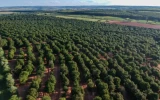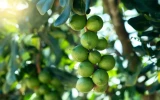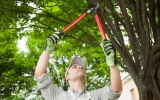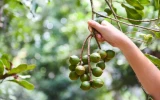Are Macadamia Trees Frost Tolerant? (3 Ways to Protect Them)
Native to Australia, macadamia trees don't take too kindly to freezing temperatures. While mature trees may withstand brief and mild frosts, young macadamia trees are particularly vulnerable during their formative years and can be severely damaged by frost. In this article, we'll give you three simple yet effective strategies that you can employ to shield these sensitive trees from the adverse effects of cold snaps.
Macadamias are not frost tolerant. To protect them, plant them in a location that minimizes frost exposure or apply a thick layer of mulch around the base of the tree. Additionally, you can also place heaters strategically throughout your garden to ward off frost.
You can also use frost cloths or blankets to cover young trees if an unexpected frost is forecast. As you get your macadamia trees ready to face the chill, we'll let you know some tips on how you can better prepare them.
When starting a new macadamia orchard from scratch, you need to choose a site with minimal risk of freezing temperatures or frost that could damage or kill the young trees.
Summary
- Frost can have a range of effects on macadamia trees, including damage to flowers and fruit, leaves, stems, and branches, and can also delay growth and development, as well as have long-term impacts on the trees' health and productivity.
- To minimize the impact of frost on macadamia trees, farmers frequently utilize different tactics, including implementing frost protection methods such as wind machines, heaters, or sprinkler systems to elevate the temperature in the orchard and shield the trees from freezing.
- By applying a thick layer of mulch around the base of the tree, growers can protect the roots, retain ground moisture, and maintain soil temperature, thereby protecting macadamia trees from the damaging effects of frost.

Macadamia Trees Can Be Damaged by Frost
Frost can cause significant harm to macadamia trees, particularly young ones. Cold temperatures can lead to frost burn, where leaves wilt and turn brown.
This damage can stunt the growth of the tree and, in severe cases, kill it. Mature trees are more resilient, but they still risk reduced nut yield and quality if exposed to frost.
Young macadamia trees are more vulnerable to frost, especially during their first two years. The critical time is when temperatures drop to about 25–35 °C (77–95 °F).

To gauge the risk of frost damage, consider the tree's age, height, and the local minimum temperature. If the tree’s foliage begins to show signs of browning or wilting, it may be experiencing frost damage.
Frost can have a range of effects on macadamia trees, particularly when temperatures drop below freezing. The impact of frost on macadamia trees can be significant and may include the following effects:
It can cause damage to flowers and fruit
Frost can damage the flowers and developing fruit of macadamia trees. When temperatures fall below freezing, the water inside the plant cells can freeze, causing the cells to burst. This can lead to wilting, browning, and ultimately the death of flowers and young fruit.
It can cause damage to the leaves
Frost can cause damage to the leaves of macadamia trees, leading to browning, wilting, and necrosis. This can affect the tree's ability to photosynthesize and produce energy, potentially impacting overall growth and yield.
If you're curious about why the leaves of your macadamia trees are turning brown, find out more in this article.
It can damage stems and branches
In severe cases, frost can cause damage to the stems and branches of macadamia trees. The freezing temperatures can lead to the formation of ice crystals within the plant tissues, resulting in cellular damage and potentially causing the dieback of branches.
It can delay growth and development
Frost can also delay the growth and development of macadamia trees. If the trees are exposed to frost during critical growth stages, such as bud break or flowering, it can disrupt the normal developmental processes and lead to reduced yields in the subsequent season.
It can have a long-term impact on the trees
Repeated exposure to frost can have long-term effects on macadamia trees, weakening their overall health and making them more susceptible to diseases and pests. It can also impact the overall productivity and profitability of macadamia orchards.
To mitigate the effects of frost on macadamia trees, growers often employ various strategies, such as using frost protection measures like wind machines, heaters, or sprinkler systems to raise the temperature in the orchard and protect the trees from freezing.
Additionally, selecting frost-tolerant macadamia cultivars and planting in locations less prone to frost can help minimize the impact of frost on macadamia trees.
Protecting Macadamia Nut Trees From Frost
Protecting your macadamia trees from frost ensures their growth and productivity. By taking preventive measures, utilizing active protection methods, and choosing appropriate varieties, you can enhance your trees' resilience against cold snaps.
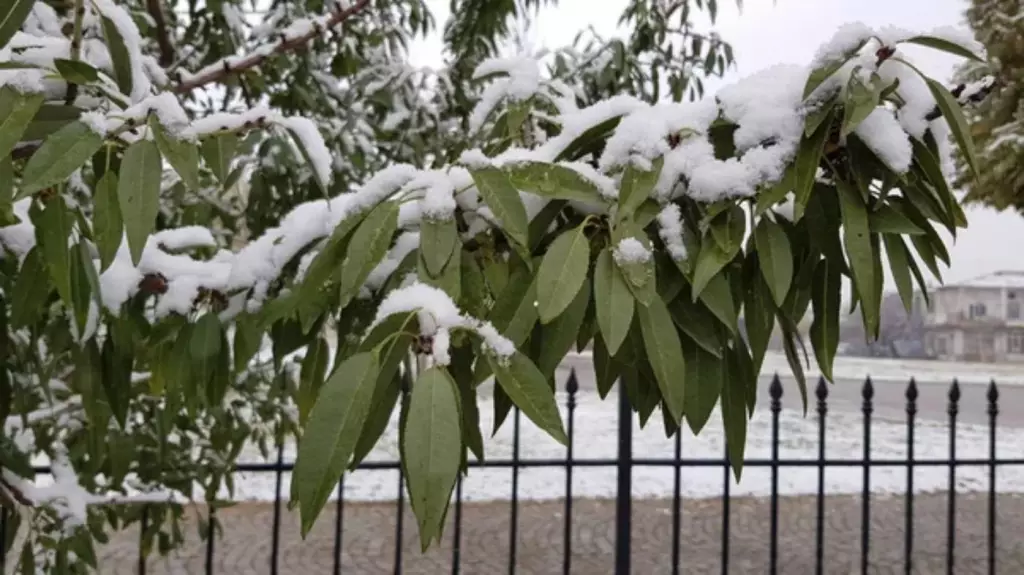
1. Prepare your macadamia trees for the cold days by taking preventive measures and care
Macadamia trees are sensitive to cold temperatures, and exposure to freezing conditions can lead to significant damage, including leaf burn, branch dieback, and even tree death. It is one of the reasons why it can be challenging to grow in regions with prolonged cold temperatures.
Therefore, implementing strategies to protect macadamia trees from cold snaps is essential for maximizing their potential yield and overall well-being.
Plant your macadamia in a location that minimizes frost exposure
Choosing a location that offers natural protection from cold winds and frost can significantly reduce the trees' vulnerability to sudden drops in temperature.
Areas with good air drainage and some protection from prevailing winds can reduce the likelihood of frost settling on your trees.
Make sure to plant your macadamia trees in a spot that shields them from cold winds. Walls, fences, or other natural windbreaks offer protection and can make a significant difference in temperature.
Additionally, planting macadamia trees in well-drained soil can help prevent waterlogging, which can make the trees more susceptible to cold damage.
Optimal altitude range for macadamias
Macadamia trees tend to grow at various altitudes, but the risk of frost increases with elevation. They are best suited for tropical and subtropical climates where the altitude is not too high to avoid frequent freeze events.
Ideal conditions for macadamia trees typically include temperatures that support tree health without exposing the trees to extreme cold that can lead to frost damage and compromise the quality of the macadamia nuts.
Implement mulching and thorough soil care
Apply a thick layer of mulch around the base of the tree to protect the roots and help retain ground moisture. Using organic matter such as compost or manure can improve soil health and help macadamia trees withstand colder temperatures.
- Purpose: Mulch helps to maintain soil temperature and moisture.
- Materials: Use organic material such as straw, wood chips, or bark.
- Thickness: Aim for a layer about 4 to 6 inches deep for optimal insulation.
Keep the soil adequately watered
Implementing proper irrigation practices can contribute to the trees' resilience against cold snaps. Adequate soil moisture can act as a thermal buffer, helping to moderate temperature fluctuations and protect the trees from the damaging effects of frost.
However, it's essential to avoid overwatering, as excessive soil moisture can also increase the risk of cold-related stress.
- Best time to water: Water in the morning on days when frost is not expected overnight.
- Quantity: Provide enough water to moisten the root zone.

Properly prune your macadamia trees to remove dead or excess growth
Regular pruning to maintain a well-structured canopy can improve air circulation and sunlight penetration, reducing the likelihood of frost damage to the trees.
Additionally, removing any dead or diseased wood can help the trees allocate more resources to maintain their overall health and resilience. Check out this article to know when is the best time to prune macadamia trees.
2. Utilize active frost protection methods
When temperatures drop to freezing or below, trees are at risk of suffering damage to their tissues and overall health. By implementing active frost protection methods, tree owners can mitigate the potential damage and help their trees withstand the harsh effects of cold weather.
Use water to safeguard your trees
Water releases heat as it freezes, protecting the blossoms and leaves from frost damage. One of the most commonly used active frost protection methods is overhead irrigation.
This technique involves spraying water over the trees during periods of freezing temperatures. As the water freezes on the tree surfaces, it releases latent heat, which helps to maintain the temperature of the tree tissues just above freezing.
Use wind machines or fans
These devices help to circulate the air around the trees, preventing the formation of stagnant, cold pockets of air. By keeping the air in motion, the risk of frost damage is reduced, as the moving air helps to maintain a more uniform temperature around the trees.
Add heat to the environment
This can be done through the use of heaters placed strategically throughout your garden to raise the ambient temperature and ward off frost. Placing heat lamps or heaters can provide localized warmth to trees during cold snaps. This can be particularly effective for smaller or more vulnerable trees that are at risk of frost damage.
Purchase frost cloth or blankets
Covering trees with frost cloth or blankets can provide insulation and protection against freezing temperatures. These covers help to trap the heat radiating from the ground and the trees themselves, creating a warmer microclimate around the trees and reducing the risk of frost damage.
3. Choose the right varieties
When selecting a macadamia variety, you might need to consider its cold tolerance, as this will directly impact the tree's ability to withstand frost and cold temperatures. Some key factors to consider when choosing a macadamia variety for cold resilience include the following:
Certain macadamia varieties are naturally more cold-tolerant than others
Varieties that have been bred or selected for their ability to withstand colder temperatures are better equipped to handle sudden cold snaps or frost events.
By choosing a cold-tolerant variety, you can ensure that your trees are better prepared for unexpected temperature drops. You can check out the different types and varieties of macadamia in this article to find out which is cold-tolerant.

Select a well-suited variety for your region
Varieties that are adapted to cooler climates or that have demonstrated resilience in colder regions are more likely to withstand cold snaps and frost. By choosing a variety that is a good match for your climate, you can enhance the overall resilience of your macadamia trees.
Different macadamia varieties may have varying growth habits
For example, some varieties may exhibit earlier or later flowering patterns, which can affect their susceptibility to frost damage. By selecting a variety of growth habits that align with your local climate and frost risk, you can minimize the potential impact of cold weather on your trees.
